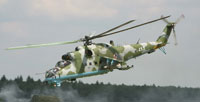|

|
|

|
The Mi-24,
the first helicopter to enter service with the Russian Air Force as an
assault transport and gunship, was developed on the basis of the
Mi-8's propulsion system.
Additional missions include direct air support, anti-tank, armed
escort, and air to air combat. The helicopter was used extensively in
the Afghanistan War, becoming the "signature" weapon of the conflict.
The Mi-24 is a close counterpart to the American AH-64 Apache, but
unlike this and other Western assault helicopters it is also capable
of transporting up to eight troops. The Russians have deployed
significant numbers of HINDs in Europe and have exported the HIND to
many third world countries.
The five-blade main rotor is mounted on top of the fuselage midsection,
while short, stubby, weapon-carrying wings are mounted at the fuselage
midsection. Two turboshaft engines are mounted above the body midsection
with two round air intakes located just above the cockpit and exhaust
ports on the sides of engines. The Hind A fuselage consists of a
large, oval-shaped body with a glassed-in cockpit, tapering at the
rear to the tail boom. The Hind D fuselage features nose modification
with tandem bubble canopies, and a chin-mounted turret. The swept-back
tapered tail fin features a rotor on the right on some models, with
tapered flats on a boom just forward of the fin.
External stores are mounted on underwing external stores points. Each
wing has three hardpoints for a total of six stations. A
representative mix when targeting armour formations would be eight
AT-6 ATGMs, 750x 30mm rounds, and two 57mm rocket pods. The aircraft
can store an additional ammunition basic load in the cargo compartment
in lieu of carrying troops. Armoured cockpits and titanium rotor head
able to withstand 20mm cannon hits. Every aircraft has an over
pressurisation system for operation in a NBC environment.
The HIND’s wings provide 22% to 28% of its lift in forward flight. In
a steep banking turn at slower airspeeds, the low wing can lose lift
while it is maintained on the upper wing, resulting in an excessive
roll. This is countered by increasing forward airspeed to increase
lift on the lower wing. Because of this characteristic, and the
aircraft’s size and weight, it is not easily manoeuvrable. Therefore
they usually attack in pairs or multiple pairs, and from various
directions.
|
MI-24 HIND
(EXPORT DESIGNATION MI-35) Specifications |
|
Type |
Assault
transport helicopter and gunship |
|
Manufacturer |
Mil |
|
Accommodation |
Two pilots and up to eight
troops or four stretchers |
|
Armament |
12.7mm 4x barrel machinegun, 30mm twin
barrel cannon, AT-2C or AT-6C Spiral ATGMs, 80mm S-8 rocket pods (20
ea.), 57mm S-5 rocket pods, GSh-23L twin 23mm MG pods, 250kg bombs
FAB-250, 500kg bombs |
|
Performance |
Max
speed 168mph (330km/h) |
|
Main Rotor Diameter |
17.3m |
|
Length |
17.5m |
|
Height |
6.5m |
|
Weight |
max take off weight 12,000kg |
|
Powerplant |
Two Isotov TV-3 turbines producing 2,200shp
(1,600kW) each |
|
Variants |
Export version of the
Mi-24 |
|